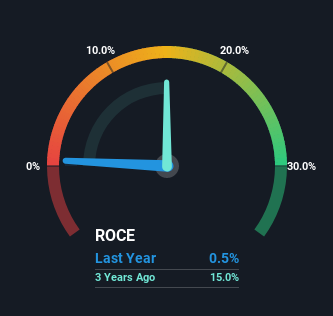- Brazil
- /
- Specialty Stores
- /
- BOVESPA:AMAR3
Marisa Lojas' (BVMF:AMAR3) Returns On Capital Not Reflecting Well On The Business

What are the early trends we should look for to identify a stock that could multiply in value over the long term? Typically, we'll want to notice a trend of growing return on capital employed (ROCE) and alongside that, an expanding base of capital employed. If you see this, it typically means it's a company with a great business model and plenty of profitable reinvestment opportunities. Having said that, from a first glance at Marisa Lojas (BVMF:AMAR3) we aren't jumping out of our chairs at how returns are trending, but let's have a deeper look.
Return On Capital Employed (ROCE): What Is It?
Just to clarify if you're unsure, ROCE is a metric for evaluating how much pre-tax income (in percentage terms) a company earns on the capital invested in its business. The formula for this calculation on Marisa Lojas is:
Return on Capital Employed = Earnings Before Interest and Tax (EBIT) ÷ (Total Assets - Current Liabilities)
0.0049 = R$12m ÷ (R$3.6b - R$1.2b) (Based on the trailing twelve months to September 2022).
Therefore, Marisa Lojas has an ROCE of 0.5%. Ultimately, that's a low return and it under-performs the Multiline Retail industry average of 5.3%.
See our latest analysis for Marisa Lojas

Above you can see how the current ROCE for Marisa Lojas compares to its prior returns on capital, but there's only so much you can tell from the past. If you'd like to see what analysts are forecasting going forward, you should check out our free report for Marisa Lojas.
What Can We Tell From Marisa Lojas' ROCE Trend?
On the surface, the trend of ROCE at Marisa Lojas doesn't inspire confidence. Over the last five years, returns on capital have decreased to 0.5% from 4.1% five years ago. Although, given both revenue and the amount of assets employed in the business have increased, it could suggest the company is investing in growth, and the extra capital has led to a short-term reduction in ROCE. And if the increased capital generates additional returns, the business, and thus shareholders, will benefit in the long run.
On a side note, Marisa Lojas has done well to pay down its current liabilities to 34% of total assets. So we could link some of this to the decrease in ROCE. Effectively this means their suppliers or short-term creditors are funding less of the business, which reduces some elements of risk. Since the business is basically funding more of its operations with it's own money, you could argue this has made the business less efficient at generating ROCE.
The Bottom Line On Marisa Lojas' ROCE
Even though returns on capital have fallen in the short term, we find it promising that revenue and capital employed have both increased for Marisa Lojas. Despite these promising trends, the stock has collapsed 81% over the last five years, so there could be other factors hurting the company's prospects. Regardless, reinvestment can pay off in the long run, so we think astute investors may want to look further into this stock.
Since virtually every company faces some risks, it's worth knowing what they are, and we've spotted 3 warning signs for Marisa Lojas (of which 1 is potentially serious!) that you should know about.
For those who like to invest in solid companies, check out this free list of companies with solid balance sheets and high returns on equity.
New: Manage All Your Stock Portfolios in One Place
We've created the ultimate portfolio companion for stock investors, and it's free.
• Connect an unlimited number of Portfolios and see your total in one currency
• Be alerted to new Warning Signs or Risks via email or mobile
• Track the Fair Value of your stocks
Have feedback on this article? Concerned about the content? Get in touch with us directly. Alternatively, email editorial-team (at) simplywallst.com.
This article by Simply Wall St is general in nature. We provide commentary based on historical data and analyst forecasts only using an unbiased methodology and our articles are not intended to be financial advice. It does not constitute a recommendation to buy or sell any stock, and does not take account of your objectives, or your financial situation. We aim to bring you long-term focused analysis driven by fundamental data. Note that our analysis may not factor in the latest price-sensitive company announcements or qualitative material. Simply Wall St has no position in any stocks mentioned.
About BOVESPA:AMAR3
Slight with imperfect balance sheet.
Similar Companies
Market Insights
Community Narratives



